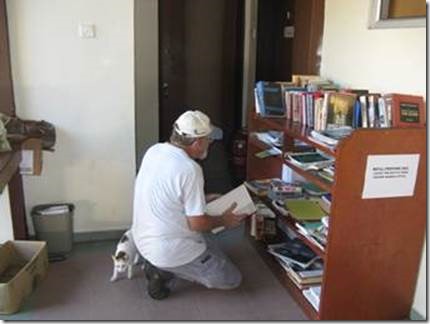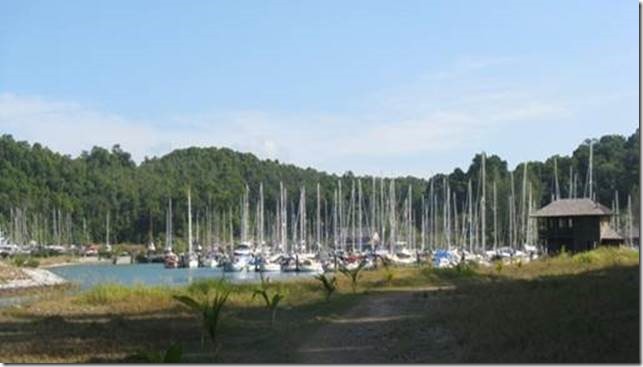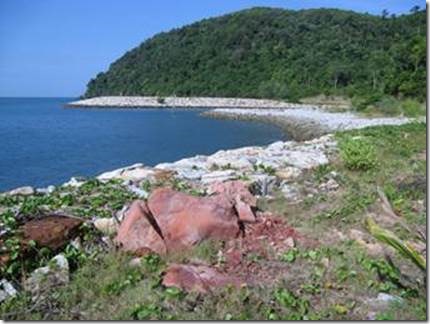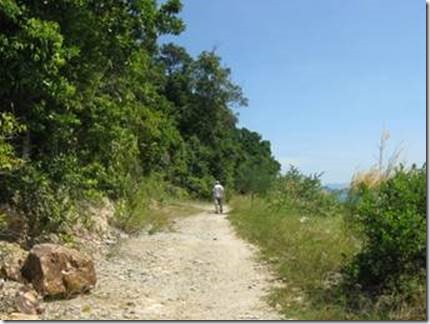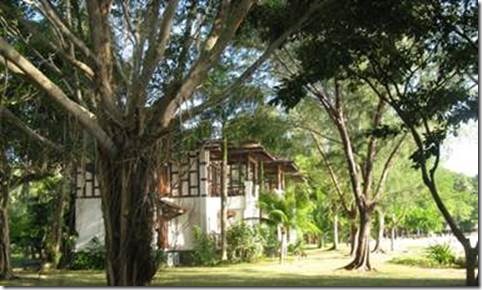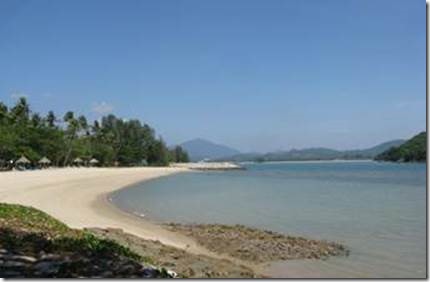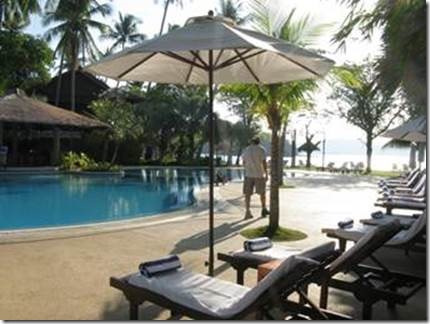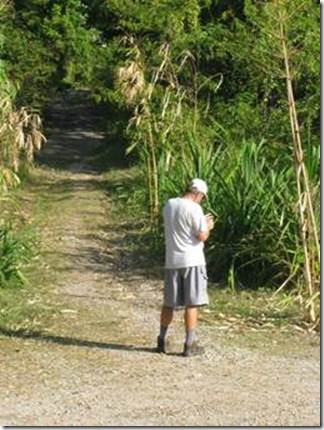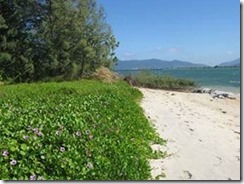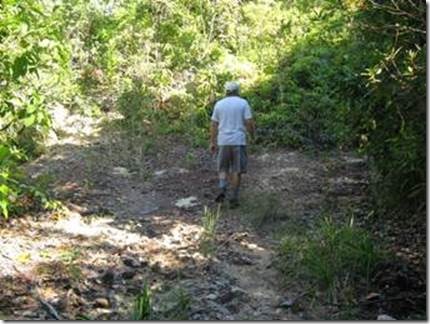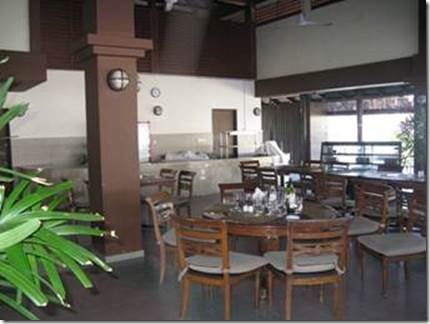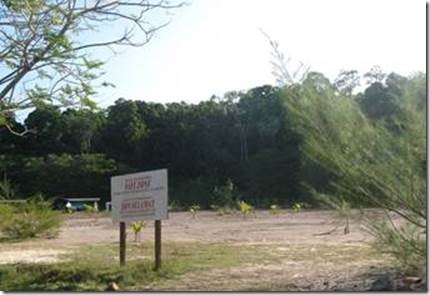Hi Everyone,
Our friend Patrick was asked to write up an article for the Royal Brunei Yacht Club magazine about his and Elizabeth’s experiences on Sail Indonesia. (They participated in 2007 and we did it in 2008.) I enjoyed reading it and Patrick said I could share it with all of you and our web site. I just wish I had better photos to go with it. I’ve written about Elizabeth and Patrick many times recently: we like them very much and truly enjoy their company and conversation.
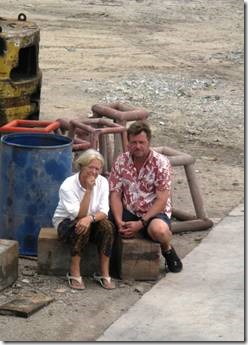
Elizabeth and Patrick
(This is not a great photo, but it’s the only one I have of the two of them together as they watched Doramac entering the Penang boat yard.)
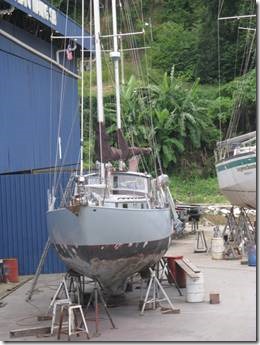
(And I don’t have a better photo of Labarque either)
TWO MONTHS IN INDONESIA
In 1990 we bought Labarque in Turkey. Although she was then 24 years old and had recently suffered a hard life in the charter business, we thought she had potential as an ocean cruising yacht. Of very heavy displacement, with a long-keeled steel hull, big fixed propeller, ketch rig, wheelhouse and teak decks, she’ll never win a race. But she’s proven a safe and comfortable home and we’ve now sailed her just over 100,000 miles.
From Turkey we delivered Labarque to England via the French Canals. Following a daunting refit, we at last set off for Vancouver in 1993. After an extended stay in Canada, we sailed for New Zealand in 1996, returning to Vancouver in 1998. From 1999-2001 we again sailed to New Zealand and back to Vancouver. In 2002-3 we did a one-year excursion to Alaska via Hawaii. We set off yet again for New Zealand in 2004, this time continuing westwards to Australia, Indonesia, Malaysia and Brunei. The following is an account of our adventures as part of the 2007 Sail Indonesia Rally from Darwin to Singapore.
Our four day voyage from Darwin was plagued with calms and very light winds and we had to motor for some 40 hours just to keep up with the tail end of the Rally fleet. In contrast, the final approach to Kupang, West Timor, was enlivened by a strong, contrary sea breeze. The crew of a heavy schooner called for help on the radio because their engine had broken and they could make little progress under sail. We towed them under power for the last few miles into the anchorage. Labarque is certainly not a high-performance sailing machine, but she’s a terrific tugboat. The Rally is not supposed to be a race, but there’s still a competitive element. Many yachts arrived a day or more ahead of us, some crews announcing that they’d sailed all the way. But some of those yachts were subsequently refuelled with suspiciously large volumes of diesel. We smelt a rat, but were perhaps just jealous.
We’d just left Darwin when we heard that Indonesian Customs and Excise had unexpectedly started to demand a (theoretically refundable) cash bond equivalent to 5% of a visiting yacht’s assessed value. We therefore made swift and sudden plans to avoid Indonesia entirely. But then we were assured that Rally yachts were exempted from the new rules. Cash bonds were demanded from other visiting yachts, all of which scattered rather than pay up. The bonds were then scrapped for a fortnight, before being mysteriously re-introduced at a 50% rate. One yacht caught by the new rules cunningly elected to join the Rally (for the standard AUS $450) after which officialdom left them alone. Still later, the regulations changed yet again and we’ve since been told that now a refundable duty is (sometimes) demanded of between a fifth and a half of the yacht’s value (accounts differ). We doubt that there will ever be any takers.
While Customs was doing its utmost to repel foreign yachts, across the corridors of power the Ministry of Tourism was struggling to attract visitors to what it calls “tourism objects”. (We politely objected to the phrase and suggested they substitute “attractions” or “destinations” instead.) The Ministry would obviously like the world to forget about the Indonesian army’s controversial interventions into East Timor. But the Indonesian army is not a shy and retiring organization. The gateposts of a downtown barracks in Kupang are decorated with a pair of enormous concrete grenades, realistically painted and complete with pins. Many governments still recommend that their nationals stay away from Indonesia and West Timor in particular. So how could the region be promoted as a safe and interesting tourism object for foreign visitors?
One conclusion was apparently to pull out all the stops (but fortunately not the pins) for the participants of the Sail Indonesia Rally. We were to be guinea pigs for an embryonic tourist industry and ambassadors to spread the word. As guinea-pig ambassadors, we can report that there are a lot of interesting things to see. The highlights were a Gala Dinner with the Governor, followed by a Cultural Show (including a rather good pop singer from Jakarta, memorable in kinky boots) plus two 15 hour bus trips to the mountains and the last Animist village in West Timor. A Police escort with wailing sirens preceded the convoy of 10 buses; four ambulances followed in case of accident or illness. The main road from Kupang was in good repair, doubtless because it was the supply route for the fighting in East Timor. But the side roads were awful. We gently suggested to our hosts that although their current batch of guinea-pigs were well used to long hours of mild discomfort at little more than walking pace, others might find this sort of endurance sightseeing a bit exhausting. But for us it was a magical experience. The villages through which we passed had clearly seen nothing like it, except perhaps when the buses were full of soldiers. At every stop a little toilet block had been freshly built for our convenience, supplied by a water tanker. And at every stop the honoured guests were individually presented with beautiful hand-woven scarves (ikats).
Kupang is where Captain Bligh first came ashore after being ejected from HMS Bounty in 1787. These days the city is a noisy, dusty, chaotic muddle, but none the worse for that. There are so few tourists that it’s impossible to walk a city street without constant greetings of “Hello Mister! Hello Missus!, Where you from? England? David Beckham, Wayne Rooney, Chelsea, Liverpool, Arsenal, Manchester United!” There was no doubting the enthusiasm. Small motorcycles and bemos (pronounced “bee-moes”) choke the roads. Bemos are small usually Suzuki vans, individually named and elaborately painted. The windscreens of many are decorated with such a profusion of opaque transfers, furry toy animals and convex shaving mirrors that the driver has to peer through a narrow slot. On most bemos the horn has been modified to sound like a machine gun. All bemo drivers sound their horns continuously to advertise their presence to other road users, to drum up custom from pedestrians and to pretend they are shooting down the bemo in front. No road rules are apparent, except for a vague tendency to drive on the left. Fortunately, everything happens so slowly that serious accidents are less common than might be expected. But one Rally participant hired a motorcycle, crashed through the windscreen of a bemo and broke his pelvis. An air ambulance flew him back to Darwin.
Thoroughly Kupanged, we sailed for Kalabahi, the capital of Alor. The island’s bemo drivers had evidently completed bemoantic training in Kupang as the little town rang to the sound of simulated machine-gun fire. The main event was the Alor Expo, an annual festival of music, weaving and traditional dance, combined with serious efforts to promote the island to foreign investors. Tourists seemed rare and the local population genuinely pleased to see us. This was less the case in Lembata, the next scheduled island on our way west. From a scruffy anchorage near Lewoleba it took us three rough and dusty hours by open-sided truck to get to Lamalera on the south coast. Here, brave madmen still kill whales and dolphins with primitive harpoons hurled from canoes. Japanese film crews have descended on the place, presumably to stir up some positive spin on whaling. But the Japanese have worn out their welcome and ours. For us this village was the only unfriendly place in Indonesia. The truck seemed even dustier on the way home.
After sluicing off Lamalera, we sailed away to Maumere on Flores Island. Maumere was almost completely flattened by an earthquake in 1992, but by 2007 the city had been at least partially rebuilt. To mark the 62nd Anniversary of Independence on the 17th August 1945 (when the occupying Japanese threw in the towel, although the Dutch didn’t reluctantly follow suit until 1949) there were formal celebrations to which Rally participants were invited. In the presence of scores of dignitaries, expertly drilled paramilitaries in white uniforms (actually high-school children in disguise) spent 90 (interminable) minutes raising the red and white national flag that had originally been created by ripping off the blue stripe from the flag of the Dutch colonists. Noisy and slightly erratic American-style drum majorettes accompanied the performance. They seemed bizarrely out of place but gorgeous in their day-glo suits, Napoleonic hats, fluffy pom-poms and decidedly kinky boots. Sensing our bewilderment, our guide suggested that we hurriedly move on to his nearby village for an Independence Day party. Here the events included a canoe race, sack races for the young, pea/spoon races for the younger and a tug-of-war (known locally as a ‘string-pull’). With the village string-pull champions decided, the visiting boat-people were challenged. To universal astonishment, we won two string-pulls in a row, helped by arms that had spent the last few weeks working winches. But our Ladies’ team was soundly defeated and so an honourable draw declared. The highlight of the celebrations was a competition to climb three 10 metre vertical poles at the top of which were a selection of prizes. But the poles were heavily greased. The victorious visiting string-pull team was politely offered the chance to try first, but sensibly we declined. In pursuit of the prizes, squads of increasingly filthy young men formed teetering pyramids and slowly inched upwards until invariably a component failed and the team collapsed into a heap. But after about half an hour, enough of the grease on one of the poles was transferred onto the assailants and the heights were triumphantly reached.
Indonesia is the world’s largest Muslim nation, but the island of Flores is four-fifths Catholic. Improvising brilliantly, the local Regent suggested that Rally yachts anchor off the village of Maurole to help celebrate the ordination of five new Catholic priests at the local church. It took some convincing to persuade the Rally organisers that such a tiny village could provide facilities and diversions for up to 124 yachts, but in the event Maurole (and the Regent) succeeded triumphantly. Catholicism in Flores seems much jollier than the Irish version. The new priests were led in by dancing girls and their surplices featured traditional woven designs made by their families. One parishioner explained: “We’re all completely Catholic, of course. But most of us completely believe in the old ways too”. Tours were later laid on to other nearby villages. One is locally famous for making arak (an expertly-distilled palm liquor), another for a sweet brown sugar made from palm sap using “extinct tools” – which we interpreted as meaning traditional methods. On another day, we tried our hand at teaching geography, mathematics and English at two nearby primary schools and then went on to two more villages. At each our welcome was almost overwhelming. We also took a tour to the coloured crater lakes of Kelimutu, passing a magnificent valley of terraced rice paddies on the way. The terraces took centuries to build and must be resilient to have survived the periodic earthquakes that shake Flores.
From Maurole we sailed 260 miles to Makassar, the capital of Sulawesi. The local Bugis people are traditional seafarers (and allegedly recently-retired pirates) whom are apparently thought brash and aggressive by other Indonesians. They are also credited with inventing a hair oil which stained furniture and thus led directly to the development of lace antimacassars. Makassar is now a humming and sophisticated metropolis. Only twelve Rally yachts made the trip, but the city was too busy to notice. The national Jet-Ski championships were (loudly) underway and the last stage of the Indonesian Car Rally was held nearby. Transport was easy, as there were hundreds of bemos (locally called pete-petes) and thousands of pedal-powered tricycle rickshaws (becaks) cluttering the pavements and swerving slowly amongst the traffic. Becak passengers sit up front and act as primitive air-bags in the event of a head-on collision. Undaunted, we took a becak to visit an enormous air-conditioned shopping mall where Manchester United credit cards were heavily promoted. Meanwhile, just a mile away, the fishing harbour was the authentic, teeming, cheerful, reeking shambles we’d been expecting. Few sounds are more evocative than the explosive bark of twin un-silenced diesels in a Bugis fishing boat. With our ears still ringing, we set off south in search of a dragon.
The Komodo dragon is the world’s largest lizard. For us the official tours are prohibitively expensive and so we decided to cheat. We sailed to Komodo first, but saw only a wild pig snuffling in the sand. So we moved on to Rinca Island, close by to the east. And there, parading with dignity along the beach like a digital extra from Lord of the Rings, was an enormous dragon. I must have been at least three metres long from nose to tail. The crew of one yacht on the Rally returned from an official tour on Rinca to find their aluminium dinghy heavily occupied by a dozing dragon. They had to wait politely for a considerable time before it woke up and sleepily moved on. In similar circumstances our inflatable dinghy would have been torn to shreds. Counting ourselves lucky, we ticked the box marked ‘Dragons’ and sailed for Bali.
For the first time the 2007 Rally stopped on the north shore of Bali at Lovina, a long way from the surfing beaches and nightclubs of Kuta in the south. A terrific show of Balinese dancing was presented on the beach, with a backdrop of some 120 anchored yachts. Later we hired a car to explore the local sights, including a rather beautiful Hindu temple near the centre of the island. But our time in Indonesia was fast running out.
At considerable expense we’d purchased Labarque a three month Indonesian Yacht Cruising Permit in Darwin, but we could only stay for two months on ‘social visas’ that cost AUS$60 each. Applicants for a social visa need an approved ‘sponsor’ to vouch for them. The Rally organisers acted as our sponsor and so that particular hurdle was easy. But after eight days in Bali our 60 days were up and rather than pay for two new 60-day social visas (of which we could only use 30 days because Labarque’s non-renewable Cruising Permit would then expire) we decided to move on. At the latest we had to leave on the Monday, so the previous Thursday we’d handed in our passports, expecting them back the next day.
We hate it when officials take away our passports. Of all the 34 countries we’ve visited aboard Labarque, only the Cape Verde Islands (in 1993) and Indonesia have insisted. Friday came and went, and of course little happens at the weekend. Nothing happened on Monday either and it wasn’t until the Wednesday morning that our passports reappeared. By then there had been another development. Friends on another yacht had just suffered a broken gearbox. We suggested that they sail with us so that we could escort (and when necessary tow) them to Singapore for repairs. Then there were yet further complications. The Indonesian Immigration Service pointed out that we’d over-stayed our visas and were therefore liable to fines totalling 800,000 Rupiah (AUS$125). “But hang on” we said. “We couldn’t leave on Monday because you had our passports.” “The reason for the over-stay is irrelevant” they said. Although 800,000 Rupiah is not a huge amount of money, we were determined to make them work for it. By the Wednesday afternoon, “frank, bordering on direct” discussions had been going for six hours when at last they relented (stamping our passports for the previous Sunday) and we were cleared to depart.
Thus it wasn’t until the Thursday that we finally set off in Labarque with our friend’s Invictus IV (swiftly renamed La Barge) in tow. Two months earlier we’d towed one yacht into Indonesia and now we were towing another one out. When the wind blew (albeit feebly) we cast off La Barge to sail in company, although Invictus IV had to be heavily reefed to travel sufficiently slowly. This was further proof (as if proof were needed) that Labarque is a dismal sailing machine, especially in light airs. But after 146 hours of ponderous sailing, 65 hours of towing and a total of 960 miles, we’d together crossed the (shockingly busy) Singapore Straits and arrived at Raffles Marina in Singapore. Invictus IV now has a new engine and is well on her way back home to America.
In 2008 we sailed north to Penang and Langkawi before heading for Sarawak, Sabah, and of course the warm welcome always offered by the Royal Brunei Yacht Club. This year we explored Phuket in Thailand before returning to our favourite destinations in Borneo. We expect to be hovering around these parts for a while yet.
Patrick Southall & Elizabeth Fowler
Yacht Labarque
August 2009.
